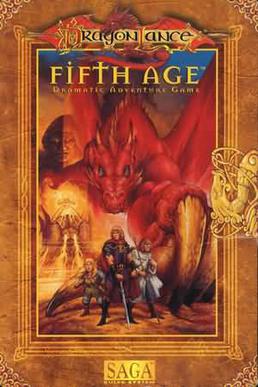I started to feel that I didn’t know roleplaying games well enough so I came up with the plan to read a roleplaying game corebook for every year they have been published. Selection criteria is whatever I find interesting.

Dragonlance: Fifth Age represents something quite unusual in the history of roleplaying: A D&D setting ported to a new system by TSR. In fact, I can’t immediately think of another example. Usually, D&D settings and properties have been exclusively wedded to their rules systems.
Fifth Age is an update on the Dragonlance campaign world familiar from the Chronicles and Legends novel trilogies. It’s set three decades after the events of the novel Dragons of Summer Flame in which the world of Krynn experienced a new Cataclysm. This time, gods and magic have receded from the world, to be replaced by a different kind of magic and a bunch of titanic dragons who each rule over a wide section of the continent.
Looking at the changes to the setting, it feels like the goal is to do the same basic thing that acted as the original impetus of Dragonlance when it was first conceived: Make dragons cool again. The method is also the same, making them bigger and scarier than before. Since they were already quite big, they’re now truly titanic, world-defining monsters that cannot be defeated except through extraordinary means.
I first came into contact with Dragonlance as a child, reading the Finnish translation of Dragons of Autumn Twilight. At that age, the Christian subtext of the stories totally eluded me. Now when I read Fifth Age, these themes are extremely obvious, especially in the original Fourth Age era of the War of the Lance. The Biblical Flood has a parallel in the Cataclysm and the heroes are seeking signs of the true faith in a world of people who have lost their way. In Fifth Age these themes are downplayed in favor of a fight for liberation against really big dragons.
Fifth Age describes itself as a narrative, story-based game, fitting for the Dragonlance setting which is most clearly defined by novels. It’s card-based, with a system reminiscent of that in Castle Falkenstein. Players have hands and can decide which card to play. You can purposefully play bad cards to keep the good ones for later or try to gauge the difficulty of the task so that you play a card that’s just good enough. In this way, the system gives some narrative control to the players.
The magic system in Fifth Age follows the Nineties fashion for loose mechanics that allow for inventing new magical effects within a given theme such as pyromancy. Everway and Mage: the Ascension have similar systems.
More than most games I’ve read, Fifth Age feels like it’s caught in the conflux of a number of different trends of game design, past and future. Much of its presentation and setting design is classic Nineties TSR. “Good” and “Evil” are capitalized. The player characters are heroes. The sample adventure isn’t much different from a D&D module. It even has a dungeon, although it’s now broken down into scenes instead of rooms.
At the same time, the rhetoric about being a “Dramatic Adventure Game” is a harbinger of things to come. Narrative focus in a roleplaying game became big in the 2000s and a lot of the design in Fifth Age is clearly influenced by 90s trends such as open design that gives the GM and the players a lot of interpretative freedom.